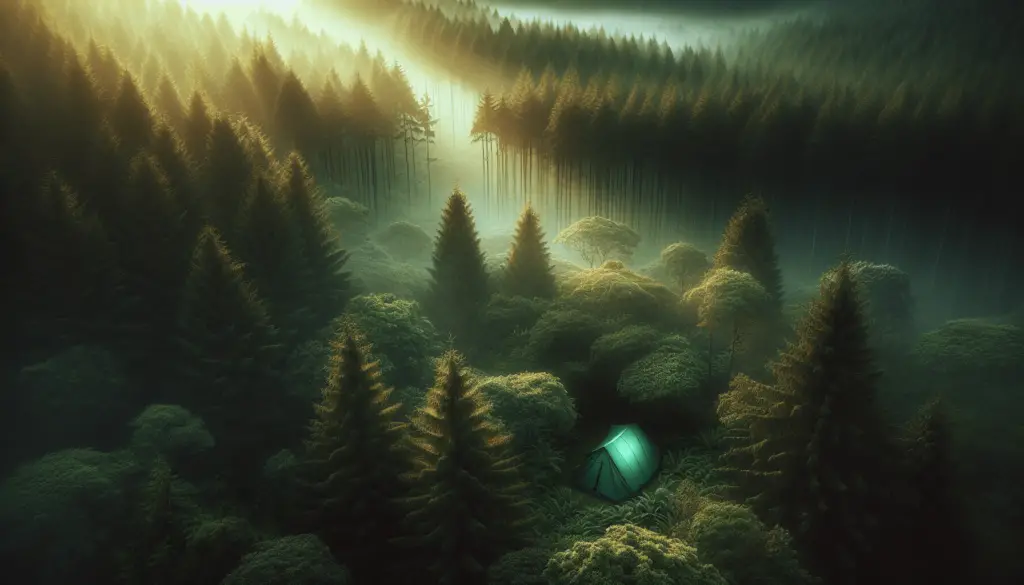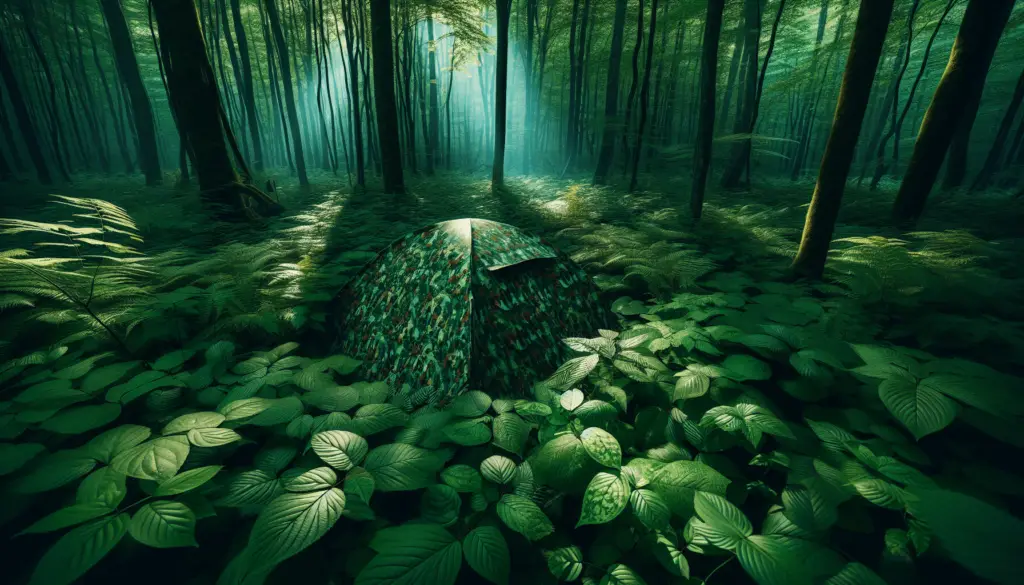Welcome to the world of stealth camping, where you master the art of blending seamlessly into your surroundings to camp undetected in nature. Being able to set up camp without drawing attention to yourself allows you to enjoy the beauty of the outdoors without disturbing wildlife or attracting unwanted attention. In this article, you will learn tips and tricks on how to effectively hide your presence while camping in the wilderness, ensuring a harmonious and peaceful experience with nature. So grab your gear and get ready to embrace the challenge of stealth camping! Have you ever wanted to experience the thrill of camping in the great outdoors without the restrictions of designated campgrounds? If the idea of blending into your surroundings, setting up camp in hidden locations, and truly immersing yourself in nature excites you, then stealth camping might be just what you’re looking for. In this guide, we’ll explore the art of stealth camping and share tips on how to seamlessly blend into your surroundings for a one-of-a-kind outdoor adventure.

What is Stealth Camping?
Stealth camping is the practice of setting up camp in an inconspicuous manner in areas where camping may not be explicitly allowed or permitted. It involves finding hidden or secluded spots in natural environments, urban settings, or even on private property without drawing attention to yourself. The goal of stealth camping is to minimize your impact on the environment, avoid detection, and enjoy a unique camping experience that allows you to connect with nature on a deeper level.
Embracing the Element of Surprise
Stealth camping is all about tapping into your inner adventurer and embracing the element of surprise. By keeping a low profile and blending seamlessly into your surroundings, you can experience the thrill of camping in unconventional locations while staying under the radar. It’s an opportunity to test your wilderness skills, resourcefulness, and ability to adapt to changing circumstances as you navigate through different environments.
Choosing the Right Location
One of the key aspects of successful stealth camping is choosing the right location for your campsite. While the idea of camping in remote, secluded areas may sound appealing, it’s essential to consider a few factors before setting up camp. Here are some tips to help you select the perfect spot:
Researching Potential Campsites
Before embarking on your stealth camping adventure, take the time to research potential campsites in the area where you plan to camp. Look for hidden spots that are off the beaten path, away from popular trails or tourist destinations. Online forums, topographic maps, and satellite imagery can be valuable resources for identifying suitable locations for stealth camping.
Scouting the Area
Once you’ve identified a few potential campsites, it’s important to scout the area before setting up camp. Take a walk or hike around the site to familiarize yourself with the surroundings, assess potential risks or obstacles, and determine the best placement for your campsite. Look for natural features such as dense foliage, rock formations, or bodies of water that can provide cover and help conceal your camp from view.
Avoiding Private Property
When selecting a location for stealth camping, make sure to avoid private property unless you have obtained permission from the landowner. Trespassing on private land can lead to legal consequences and compromise the principles of stealth camping. Stick to public lands, national forests, or other designated camping areas where camping is allowed, or seek out hidden spots in urban settings that are unlikely to attract unwanted attention.

Blending In With Your Environment
Once you’ve chosen a suitable location for your stealth camping adventure, the next step is to blend in with your environment to avoid detection and minimize your impact on the surroundings. Here are some tips for blending seamlessly into your surroundings:
Choosing the Right Gear
When it comes to stealth camping, less is more. Opt for lightweight, compact gear that is easy to carry and set up quickly. Choose earth-toned or camouflage-colored equipment to blend in with the natural surroundings and avoid drawing attention to your campsite. Consider using a bivy sack or a small tent that can be concealed easily in dense foliage or behind rocks.
Camouflaging Your Camp
To camouflage your camp and make it less visible to passersby, use natural materials such as branches, leaves, and rocks to disguise your tent or shelter. Arrange your gear strategically to create a minimal footprint and avoid leaving traces of your presence. Avoid using bright colors or reflective surfaces that can stand out in the environment and attract unwanted attention.
Minimizing Noise and Light
In a stealth camping situation, it’s crucial to minimize noise and light to avoid alerting others to your presence. Keep conversations and activities quiet, use dim, red-colored lights instead of bright white lights, and avoid making unnecessary noise that can carry through the surroundings. Be mindful of your surroundings and respect the peace and tranquility of the outdoor environment.
Practicing Leave No Trace Principles
As a stealth camper, it’s essential to adhere to Leave No Trace principles to minimize your impact on the environment and preserve the natural beauty of the places where you camp. Here are some guidelines to follow:
Pack It In, Pack It Out
Take responsibility for your waste and pack out all trash, including food scraps, packaging, and other items. Leave the campsite cleaner than you found it and dispose of waste properly in designated receptacles or by carrying it out with you. Practice Leave No Trace ethics by leaving nothing behind except footprints.
Respect Wildlife
Avoid disturbing wildlife or encroaching on their habitats while stealth camping. Keep a safe distance from animals, refrain from feeding them, and observe them from a distance without causing harm or disruption. Respect the natural behaviors of wildlife and refrain from leaving food or waste that could attract unwanted attention.
Leave Natural Features Intact
When setting up camp in natural environments, avoid damaging vegetation, disturbing soil, or altering the landscape in any way. Use existing campfire rings or designated fire pits if fires are permitted, and follow local regulations for gathering firewood or foraging for natural resources. Leave natural features intact and undisturbed for others to enjoy.
Safety Considerations
While stealth camping can be an exhilarating and rewarding experience, it’s essential to prioritize safety and be prepared for unexpected situations. Here are some safety considerations to keep in mind:
Tell Someone Your Plans
Before embarking on a stealth camping adventure, make sure to inform a trusted friend or family member of your plans, including your intended location, duration of the trip, and expected return date. Provide them with contact information and emergency procedures in case of an unforeseen event or emergency.
Carry Emergency Supplies
Pack essential supplies and emergency gear to ensure your safety while stealth camping. Bring a first aid kit, navigation tools, extra food and water, a communication device such as a cell phone or a satellite messenger, and any other items that may be necessary in case of an emergency. Be prepared for changing weather conditions and unexpected challenges.
Be Mindful of Local Regulations
Before engaging in stealth camping, familiarize yourself with local regulations, restrictions, and guidelines for camping in the area where you plan to camp. Observe posted signage, respect park rules and regulations, and obtain any necessary permits or permissions required for camping in designated areas. Be aware of potential hazards such as wildlife encounters, inclement weather, or natural disasters.
Conclusion
Stealth camping offers a unique opportunity to connect with nature, test your skills, and experience the thrill of camping in unconventional locations. By blending into your surroundings, minimizing your impact on the environment, and practicing Leave No Trace principles, you can enjoy a memorable outdoor adventure while staying under the radar. Remember to choose your campsite wisely, blend in with your environment, and prioritize safety at all times. Whether you’re a seasoned outdoor enthusiast or a beginner looking to try something new, stealth camping can provide a sense of freedom, exploration, and discovery unlike any other camping experience. Embrace the art of stealth camping and immerse yourself in the beauty of the natural world as you embark on your next outdoor adventure.
